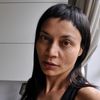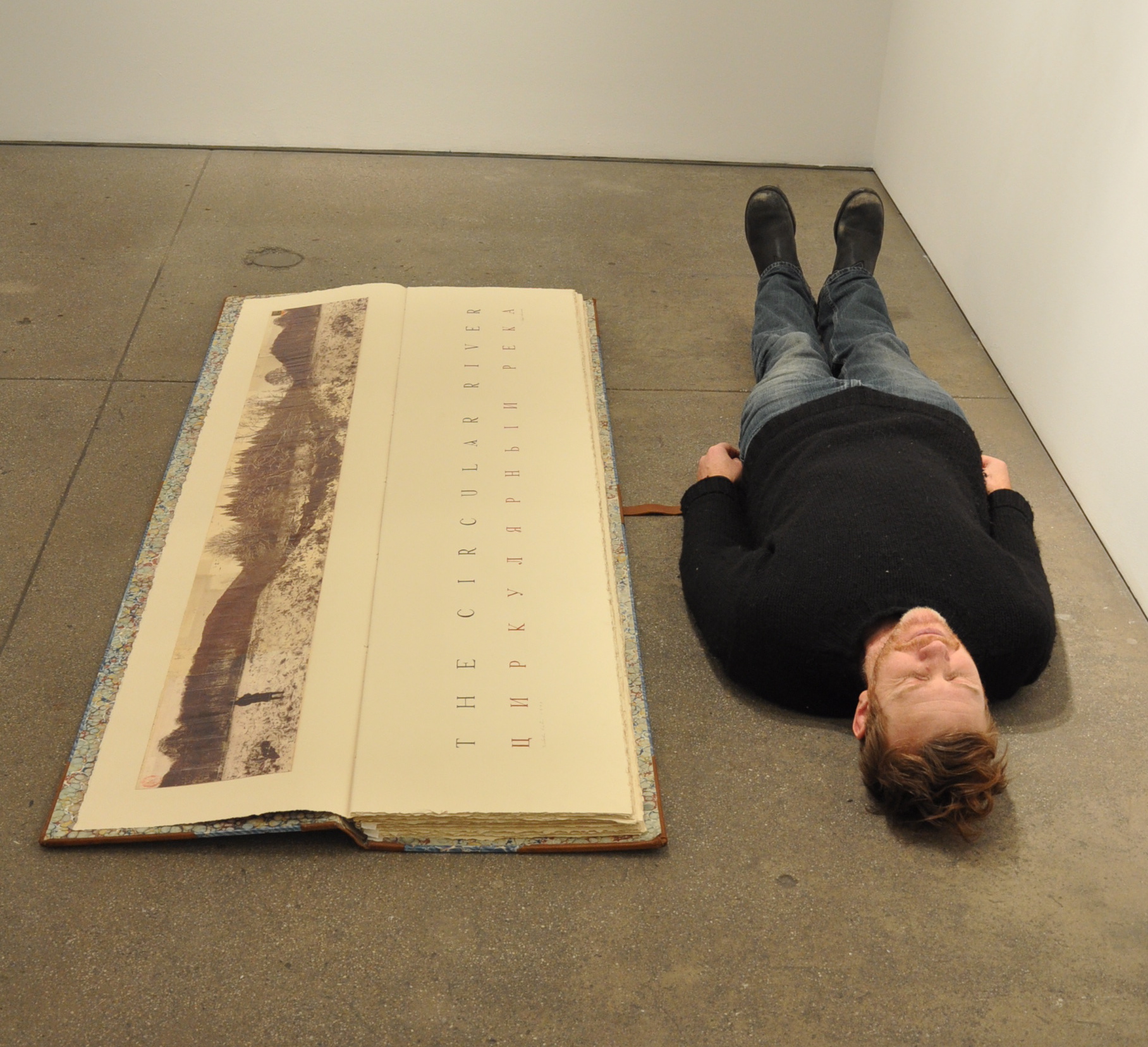
Cave, 2010, Mars: Adrift on the Hourglass Sea © Kahn & Selesnick, Courtesy of the Artist and Yancey Richardson Gallery
I found Nicholas Kahn and Richard Selesnick at their New York gallery Yancey Richardson, looking over their human-length book of the Circular River project. The book which Kahn bound is a beautifully aged tome containing the account of a fictional odyssey through Siberia with panoramic shots of a desolate landscape annotated with tales of remote viewing, shamanism and mystical adventures woven into fables with accompanying faux-artifacts.
Richard Selesnick next to his book, Circular River - Photo: Kisa Lala, 2011 -
"... The R.E.C. Siberian Expedition of 1945-46' continued the story of the R.E.C to its post-war conclusion. A seven-foot wide leather bound book held the 60 long sepia panoramas and 100 pages of text."

City of salt: ON THE EDGE OF THE MARSHES © Kahn & Selesnick, Courtesy of the Artist and Yancey Richardson Gallery
Kahn and Selesnick have been collaborating since the age of 18 when they met at university and bonded over their shared interest in English artists and vision of rural England, stone circles and mysticism. "It was odd because in St. Louis no one really cared about British artists one bit. There was no one to talk about that elsewhere in America, which was a crass ugly place - to some extent - in suburbia," says Nicholas Kahn, recalling how they would build imaginary stone-circles in parks in Washington and St. Louis, and how even now, in their 40s, Kahn declares laughing, "We are repeating the same formula from when we started...sad but true." And yet, their growing series of chronicles have culminated in an elaborate alternate history - a testament to their obsessive dedication as mythmongers.
Their current show, Mars: Adrift on the Hourglass Sea, is the story of travelers moored in a fossilized ocean on the red planet. The narrative begins with two women trying to recolonize the ice after arriving in a pod symbolic of a male seedpod. There is a birth and a baby, and esoteric references to creation myths, of Shiva floating in a pond on a bed of snakes, the double-headed Janus, the Roman god of gateways, which are woven together in an inconclusive narrative. As mythmakers they play with the idea of rewriting history, constructing artifacts - specimens from antiquity, or from a fantastic future - that become corroborative evidence to a fictional history of their own making. The projects are tied together by the greater theme of landscape: Says Selesnick, "It is about the story of man's interaction with the landscape, and each [project] is another chapter in that story."
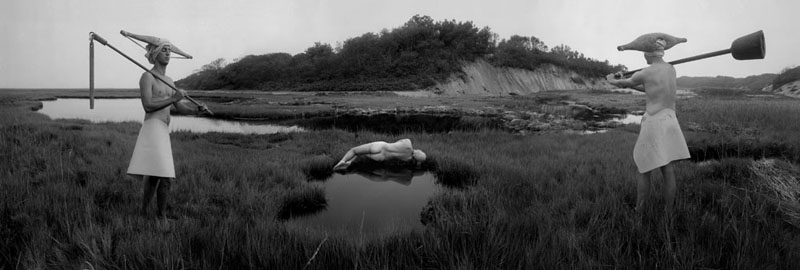
'sumpfinselwurmloch/marshishlandwormhole,' from 'Scotland Future Blog' © Kahn & Selesnick, Courtesy of the Artist and Yancey Richardson Gallery
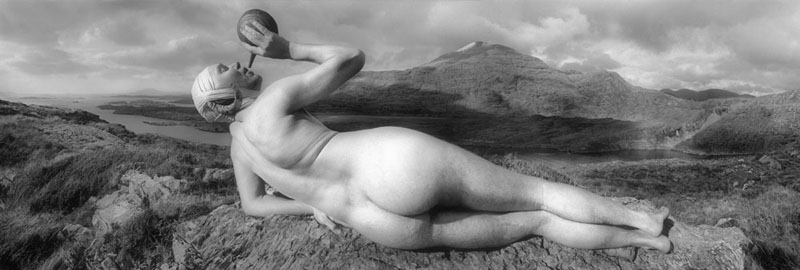
'hinterbachen/hindquarters' from 'Scotland Future Blog\' © Kahn & Selesnick, Courtesy of the Artist and Yancey Richardson Gallery"
In Circular River, their second photographic collaboration, the pages of the book appear as though out of someone's diaries, a record of the past or the future, referencing its own closed system of logic.
NK: Circular River was set in Siberia 1945-46 - two Englishmen who go in search of a lost German glider pilot who goes native, and he becomes a shaman himself. We were studying shamanism to get into the real characters here. That word comes from [the Siberian] Tungus word for shaman. There's still tribal shamanism in Russia. It got squashed by the communist regime, but it's making a revival. It's the inscriptions on these that tell the story.
RS: It's record keeping and inventory. We didn't go to Siberia, but shot it in England, Northern Scotland, Switzerland, Cape Cod and upstate NY.
KL: You have an obsession with bleak landscapes?
NK: That's why Mars is the ultimate bleak place to go to. We used a 35 mm film camera [for Circular River], and then had snapshots made. We would paste together the snapshots to make the panorama and then do it bit by bit on the Xerox machine. There is text that goes with each image.
KL: How did you begin your collaborative process? What roles do you each play?
NK: Initially we were painters, and we painted on each others' pictures. I would do a group of paintings and give them to him, or he would me, and he would do a separate one in similar style - it was good because if you weren't solving the problem yourself, someone else would finish it off."
RS: It varies. We brain storm images. We both come up with things we wanted to do.
NK: I tend to be the man who finds the costumes and often builds the props. I bound this book and Richard bound the previous book.

"Mummy Fields, Circular River 1998-99 © Kahn & Selesnick"
KL: These look like mummified gliders.
NK: There is actually one mummy, and I changed costumes in the field to made it look like many. That's our cheesy and cheap technique for most of this. It's me and Richard three different times. We were the main characters. We had three tents in the field [in Cape Cod] and we made up all the other tents. The tide came up and ruined the shoot. We have a lot of things like that happen to us...(laughs)
KL: How did you become interested in shamanism?
NK: My wife had more of an interest; she was a healer and I am more of a sham shaman.
A lot of our work does come from visions - they go into the drawings, which then work their way into the photographs eventually. Some of the ideas for the photographs come from when we are in that state.
For the Mars project one of the concepts was that the two women, are somewhat like Tibetan monks, in that they are traveling in a trance to Mars to bring back this information through advance meditation techniques. This is in a lot of our work, this magical element that grows into these other worlds through various states of mind-body traveling experiences. And as a child, I was traveling out of body a lot and flying in dreams, and that's the reason for me to want to fly in these stories. It's an escape from the mundane to the more exotic. But actually what you find [in reality] is sometimes quite hideous: I was in Nepal hang-gliding and strapped to someone operating it. It was the most gorgeous place; you could see Everest in the background. We circled up and up - and I got overwhelmingly nauseous, because to stay up there, you have to keep circling, and the motion makes everyone want to throw up; I had to close my eyes. You see everything spinning around you, and it feels like being spun on a top. So there's this dream to get to this place, but there's no ecstasy when you're finally up there - or it's mixed with horror.

The Three Travelers, City of Salt, © Kahn & Selesnick, Courtesy of the Artist and Yancey Richardson Gallery

THE EMPTY MIRROR, © Kahn & Selesnick, Courtesy of the Artist and Yancey Richardson Gallery
Kahn and Selesnick's Scotland Future Bog project is structured by a Borges-like narration describing the survival of a post-apocalyptic tribe of bog-dwellers, with supporting iconography and artifacts. In City of Salt, stories are told in the style of Calvino that conjure a magical and hallucinatory Arabian nights quest. The narratives, whose characters sometimes interconnect across different series, step through deeper visionary projections like a literary Möbius strip or an Escheresque universe where meaning is relative to itself. It was Bertrand Russell who said that every definition of meaning must necessarily lead to something yet undefined. With Kahn and Selesnick we begin and end in infinite loops that branch from the tree of history. The edges are purposefully vague; the window is left a little tarnished; the mental accuracy of the narrator is in doubt.

THE FLYER, City of Salt, © Kahn & Selesnick, Courtesy of the Artist and Yancey Richardson Gallery
KL: I see that you use many styles of narrative structures. What are your writing influences?
NK: [Originally] It came from post-modern literature. Influenced by William Blake, Stanley Spencer, Samuel Palmer... We also pull in others to help us in the writing. We like collaborating with other writers and working off their styles, but they have to enter our worlds.
KL: There's images that are in the vein of early National Geographic expeditions.
NK: Exactly, well seen. I grew up collecting [Nat Geo magazines] from the 20s and 30s, and books about exploration. Seeing the first journeys in a book from the 30s to Tibet and Lhasa got me excited about going there...[But] a lot of these projects are about going to places that I can't actually ever imagine going to. Shock of going to Nepal was going to one of these places I thought was absolutely unattainable.
RS: And we were always interested in exploration photography of bleak places like the arctic...
KL: So, are you both armchair travelers?
RS: Half of it is having the chance to recreate it in your mind. For example, in Lübeck, Germany, [for Eisbergfreistadt, 1923] we didn't go to the place till two thirds of the project was completed. We shot all sorts of miniatures and versions of Lübeck in Brooklyn. We didn't want to just photograph it. The whole point was to create a world... Going to the landscape is less interesting. Once our mythology gets added in, it gets much more interesting.
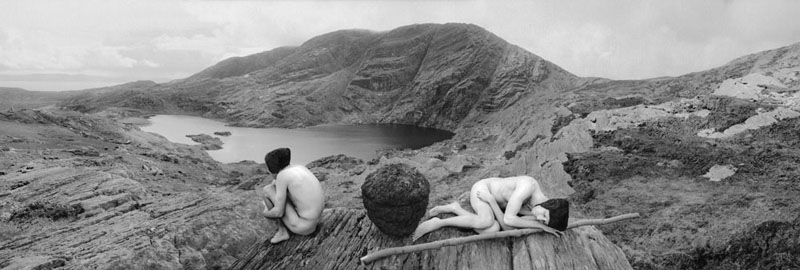 Scotland Future Bog, torfsamen/turfegg © Kahn & Selesnick, Courtesy of the Artist and Yancey Richardson Gallery
Scotland Future Bog, torfsamen/turfegg © Kahn & Selesnick, Courtesy of the Artist and Yancey Richardson Gallery
KL: I recall the timelessness in the art of Odd Nerdrum's landscapes, but your images, because they are photographs, appear to be chronicles of a definite period. The images also look flat, not realistic.
NK: He was a strong influence on the series of Scotland Future Bog. I love his vision of a post-apocalyptic northern light world. The images are similar to the way the Nat Geos were printed in 20s and 30s. They are flattened by the way they are slightly off in their colour registrations and we play off of those techniques, and so, most of ours look like water-colours.
RS: Some people think they are painted.
NK: But it's just that our aesthetic comes from the early colour printing process, which flattens it, and makes the photograph an artifact itself, rather than a window into a reality with complete verisimilitude.
RS: The photographs are sown together, which also increases the painterly look. Without quite knowing it, your mind reads it as not quite a truthful view of something.
KL: You can't see shadows or where the sun's coming from.
RS: When you actually see the stitched together shots the Rover took on Mars, they look like that anyway.
NK: And there's a weird haze on Mars. There's a kind of flattening with the dusty haze.
RS: If anything, we increased the atmospheric perspective a little bit.
NK: There is no atmospheric perspective on the moon. And so to try to make distance read is very awkward and peculiar. We are so used to atmospheric perspective in the way we understand this planet and distance.
KL: Is that because there is no reference to scale, like in the desert?
NK: Exactly, the scale of rocks can be very confusing.
RS: Something on the moon could be incredibly far distance away or very high up but the sharpness is equal to something that is very close. There is no atmosphere. So in our minds we can't tell what is where.
KL: There is no text with the current project?
RS: We oscillate between doing narratives that are very linear, and that often traps you in a certain way, so often times, we make a story that you have to read more...
NK:... with circular logic.
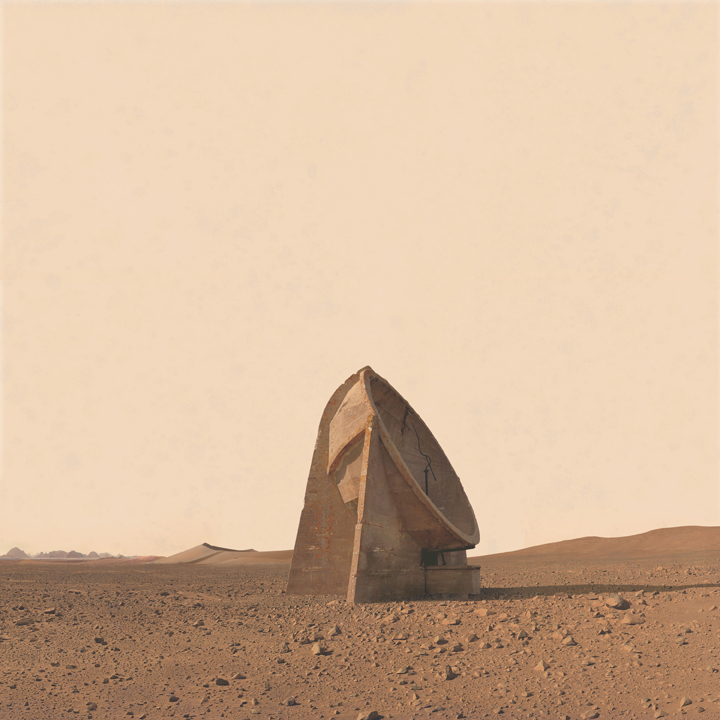
Concrete Ear 2, 2010, Mars: Adrift on the Hourglass Sea © Kahn & Selesnick, Courtesy of the Artist and Yancey Richardson Gallery

Et In Arcadia Ego 1, 2010, Mars: Adrift on the Hourglass Sea © Kahn & Selesnick, Courtesy of the Artist and Yancey Richardson Gallery
NK: Acoustic mirrors were used before radar in the south coast of England. They call them concrete ears. They pick up the sounds from incoming planes before WWI. And we figured they would have them in Mars to listen for those who helped make the civilization. We liked their particular bluntness; like obelisks. They are crumbling earpieces.
RS: They go to Mars - and maybe this is the future. Man went to Mars, lost contact with the earth. And we are somehow trying to listen for the earth. They are left listening to something that's not really there.
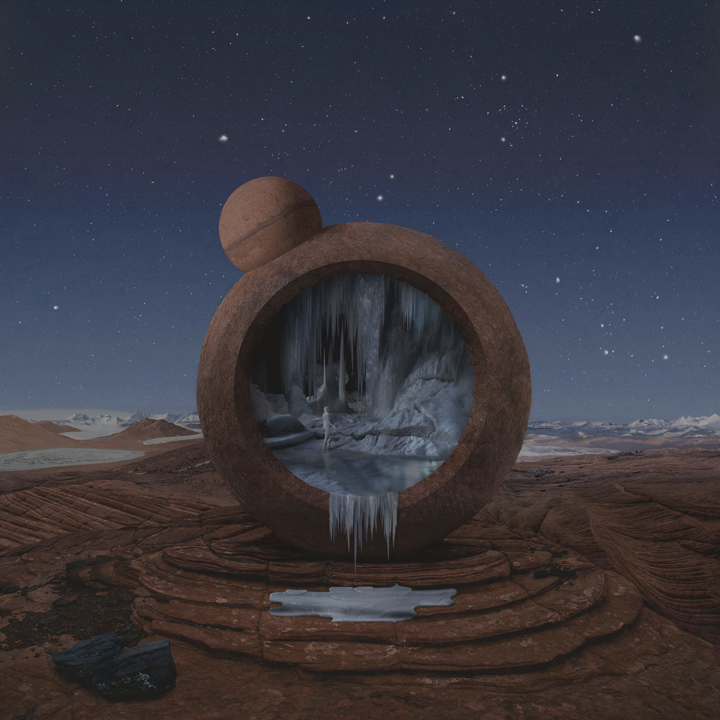
Cistern, 2010, Mars: Adrift on the Hourglass Sea © Kahn & Selesnick, Courtesy of the Artist and Yancey Richardson Gallery
RS: The sculptures are of cement imitating sandstone that is actually on Mars, which has a lot of iron in it. The round rocks are actually found on Mars - called blueberries - hematite boles - formed by water running through sandstone.
NK: The birthing, the eggs, the symbols are of becoming a double, of eggs separating in mitosis. It is a womb or a travel device.
RS: We went to certain places in Utah where they had petrified rock from some kind of volcanic event.
NK: Petrified sand dunes. Ancient seabed - but tidal.
RS: The background here is actual Mars from NASA shots. They do false colour projections to try and differentiate rocks. It was actually a blue colour. All the photos the Rover sends back is online in super high resolution for people to download.
KL: That's how the sky looks like from Mars?
NK: There should be stars in the Martian sky. A well-known cloud used to be called the blue scorpion. The clouds are probably frozen methane or carbon dioxide.
KL: Shamanism is about time travel...
NK: We are constantly studying and there's a lot of research behind this, and hopefully that will be in the service of making it timeless.
RS: We have desire to travel in time or space out of wherever we happen to be.
NK: Hence the use of inebriants or flight. [After] trying Salvia, I don't race to go back to do it. It was amazing but frightening as anything...
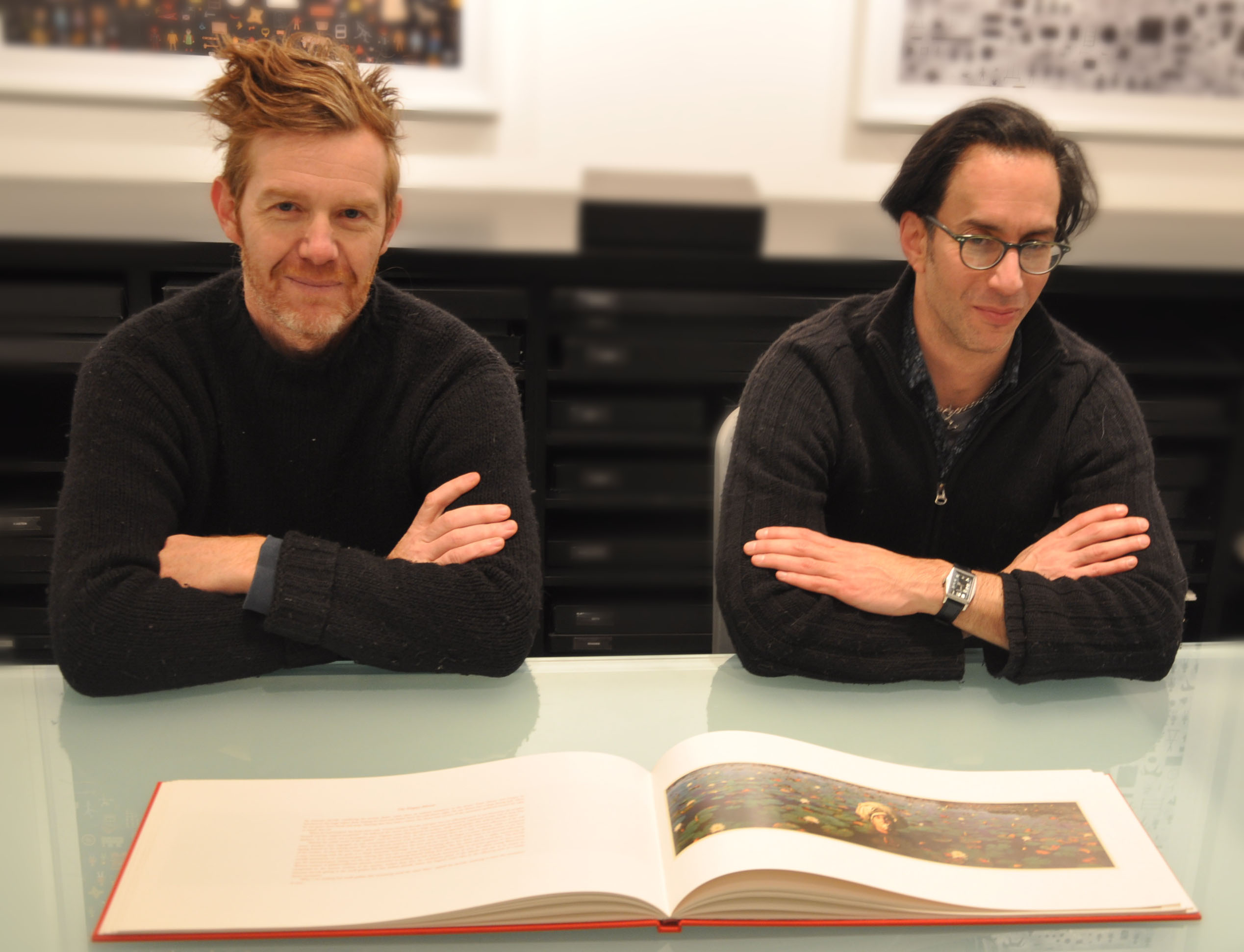
Richard Selesnick and Nicholas Kahn - photo: Kisa Lala 2011
For more information visit Kahnselesnick.com
Mars: Adrift on the Hourglass Sea January 6 - February 19, 2011
YANCEY RICHARDSON GALLERY 535 West 22nd Street 3rd floor, New York NY 10011
Text: www.kisalala.com
